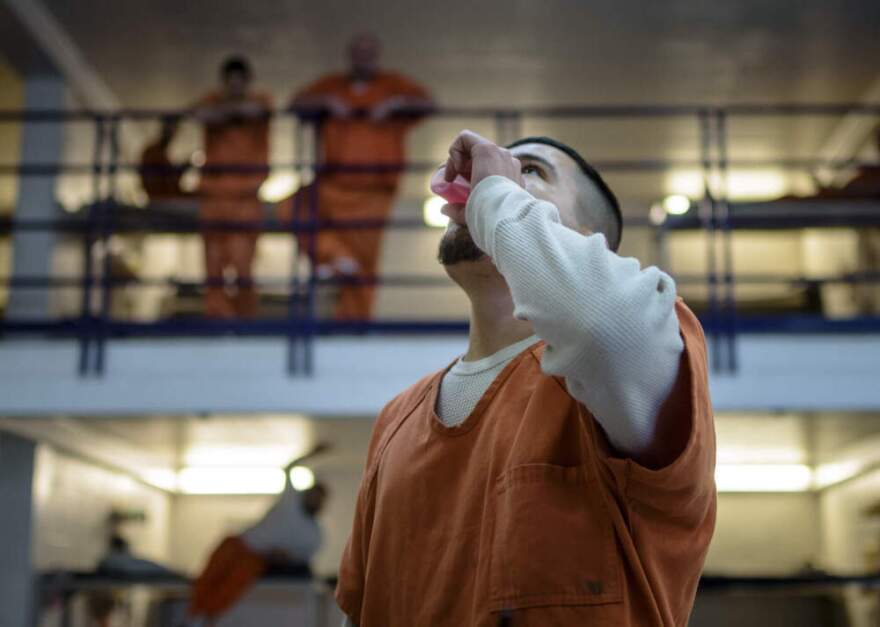
American jails aren’t as secure as you might think.
Across the country, drugs are commonly smuggled inside correctional facilities, which contributes to people overdosing and dying in custody.
“This is a nationwide issue,” Michael Dawson, deputy chief at the Maricopa County Sheriff’s Department, said. Its jail system in Phoenix is one of the largest in the country.
“We have only seen it grow through the opioid epidemic,” Dawson said. “We’ve seen everything from a few pills and some powder coming in, all the way up to 300-plus pills smuggled inside someone’s body cavity.”

So far this year, there have been 168 suspected overdoses in Maricopa County jails, and the medical examiner has ruled that six inmate deaths were drug-related.
Even a drug-sniffing dog overdosed at a local jail.
In July, Maricopa County installed new X-ray machines that can look inside a body to determine if a person getting booked into custody has a foreign object tucked into an orifice. Dawson said new K9 units trained to find drugs have also been deployed.
“Nobody out there is going to say something is foolproof,” Dawson said of the new tools. “But we are throwing everything we can at this problem.”
In a four-year period between 2019 and 2023, 375 people died of an overdose inside U.S. jails, according to analysis of a federal database of in-custody deaths obtained by reporters at The Marshall Project.
While there is no specific overdose category in the dataset, The Marshall Project isolated cases that contained words like “drugs,” “intoxication,” “fentanyl,” and “heroin,” and then reviewed each case to see if it could be attributed to illegal drug use.
Treating addiction in jail
Experts who follow this issue said the threat is real and getting worse. Dr. Nora Volkow, director of the National Institute on Drug Abuse, said about 60% of people in custody have a substance abuse disorder.
Sometimes it’s the people arrested and booked into jails who smuggle drugs inside to feed their habits. But there are also examples of correctional staff sneaking contraband past security measures.
“Definitely stopping the flow of drugs into prisons and jails would be a very important first step to curtailing the overdoses,” she said.
Volkow said more jails should be distributing drugs like methadone and Suboxone to reduce cravings for opioids and to make in-custody overdoses less likely. According to a 2023 survey of about 1,000 U.S. jails, fewer than half offered the treatment.
“In some jails and prisons, there’s still this belief that if you put someone in prison and keep them away from drugs, that will cure them, which is as far away from the truth as we know,” Volkow said.

The need for addiction medicine treatment at the Bernalillo County jail in New Mexico was much greater than Dr. Caitlin Bonney thought it would be when she started running its methadone and Suboxone program in 2023.
“I knew there would be a lot — but I didn’t expect it to be so many hundreds of patients who need these services,” said Bonney, who predicted that about half the people in custody are hooked on opioids.
The first few days of withdrawal are harrowing once someone is booked into jail.
“People describe it as the worst experience of their life,” Bonney said. “Nausea, vomiting, diarrhea. Body aches. Muscle aches. They can’t sleep. They want to die because of this withdrawal.”

And sometimes they do die because of lack of access to care and dehydration, Bonney said. That’s why people in withdrawal are among those who get first dibs on methadone or Suboxone in her clinic. But she said the waiting list for addiction treatment has about 600 names on it.
“It’s very frustrating,” she said, citing too much demand and not enough money.
Methadone and Suboxone are serious drugs in their own right that can be smuggled from a jail’s clinic into the housing units. Jail administrators and people with experience in custody told Here & Now that the drugs are in high demand on the black market in jails.
“Fifty percent of the people we start on Suboxone are removed from the program because of diversion,” said Bruce Herdman, chief of medical operations at the Philadelphia jail complex.
In response, he said the jail recently started using an injectable form of the drug.
Opioid overdose is a leading cause of death among people released from prison, according to research.
This lines up with Natasha Garcia’s experience. The former heroin user now runs the New Mexico Reentry Center in downtown Albuquerque.

“Coming from the lifestyle that we come from, not a lot of people make it out,” she said. “I’ve lost a lot of people I loved.”
Her organization helps people land on their feet after incarceration.
“There are a lot of overdoses as people are released because they go back to the street. They’ve been clean for a while. They think their tolerance is the same. They get high, and this time they may not wake up,” she said. “So being able to come out while on a medication, you come out and go straight to the clinic instead of going straight to the dope man.”
“The methadone, it’s done wonders,” said one of her clients, Manuel Lara.
He got methadone treatment in jail, and he said he’s still sober more than a year after getting out. He got a job at a plumbing company and has a new baby on the way.
“You got to think there’s something better for you out there,” he said. “Not just a pipe and piece of foil.”
This reporting was supported by the John D. and Catherine T. MacArthur Foundation.
____
Peter O’Dowd produced and edited this segment for broadcast with Catherine Welch. O’Dowd also produced it for the web.
This article was originally published on WBUR.org.
Copyright 2025 WBUR

